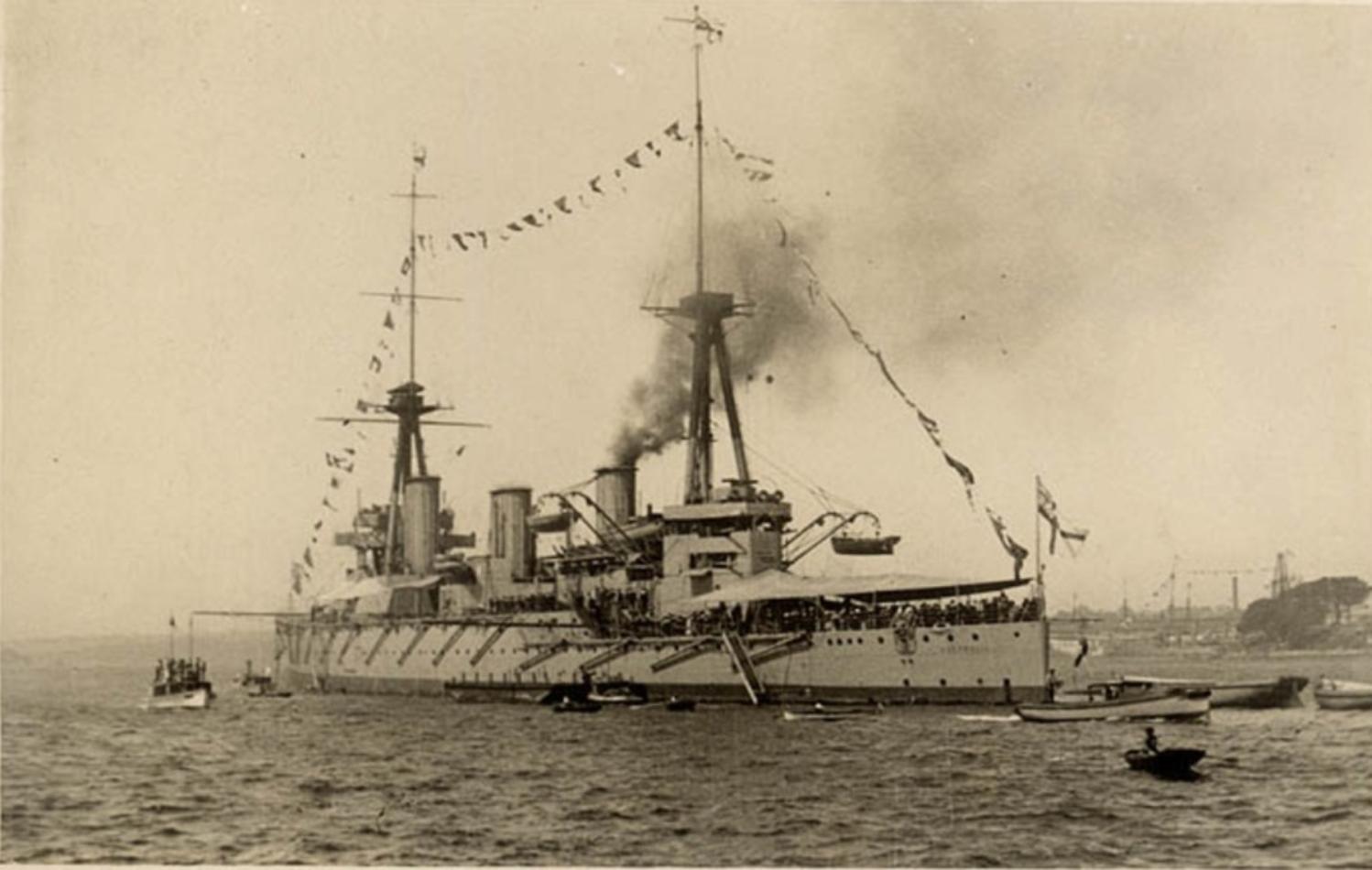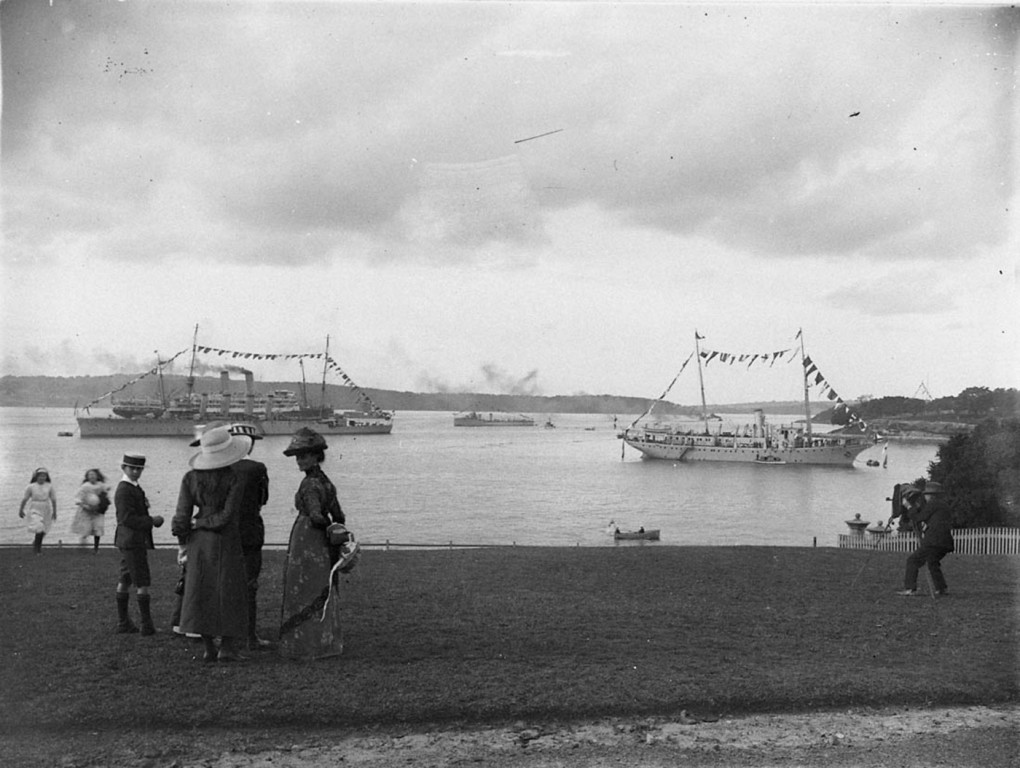The Australian Fleet Celebrations of October 1913 - A Week of Welcomes
Australia loves a Party - Australians love the birth of anything or anyone new. For a maritime nation the birth of its own Navy and the manifest vessels finally arriving in Sydney Harbour were cause for celebrations honouring those who had steered the nation's safety and those who were now taking over these duties on these ships from their commanders to the lowliest seaman. Balls, fetes, galas, dinners, dances, a theatre event and a venetian floating carnival - every strata of society offered something and everyone was included, from the highest in the land to schoolchildren who lived in rural areas.
In THE ARRIVAL OF AUSTRALIA'S NAVY IN SYDNEY HARBOUR 4TH OF OCTOBER, 2013 one article we shared mentions how Sydney was being dressed up for the arrival of the Royal Australian Navy Fleet. The first week of October was also the commencement of the Annual Spring Carnival at Randwick:
The next few weeks will pass quickly, and the arrival of the Australian fleet on Saturday, October 4, is being eagerly anticipated by thousands of Australians, who are coming from far and near to witness the entrance into Sydney Heads. By a strange coincidence the arrival of the fleet takes place the same day as the Australian Jockey Club opens its Spring meeting at Randwick. Sydney is usually very gay during the Spring racing carnival, and with the double attraction, visitors will have no time to feel dull, for we are promised much gaiety. Already we hear of a matrons' ball to be given on Wednesday, October 8, and another on Friday, October 10, and, no doubt, many other entertainments are being arranged in honour of Admiral Patey and his officers, as well as for our country visitors. His Excellency the Governor-General is, we understand, coming over from Melbourne to welcome the Australian fleet upon its arrival and will be the guest of his Excellency the Admiral at Admiralty House during his stay in Sydney. SOCIAL. (1913, September 13). The Sydney Morning Herald(NSW : 1842 - 1954), p. 6. Retrieved from http://nla.gov.au/nla.news-article15449865
Some reports from this first day of arrival:
The fleet is timed to enter the Heads at half past 10 o clock the flagship Australia leading followed by the cruisers Sydney, Encounter, and Melbourne, and the torpedo boat destroyers Warrego, Yarra and Parramatta. The vessels will be met at the Heads by steamers conveying Federal Ministers members and friends, and State Ministers and party. There will be a stately procession into the harbour and after the fleet is anchored Rear Admiral Sir George Patey, will call on Admiral Sir George King Hall on board the Cambrian and then proceed to Admiralty House where he will meet the Naval Board and be presented to His Excellency the Governor General. Afterwards the Rear Admiral will call upon the State Governor (Sir Gerald Strickland) In the afternoon a party from the war vessels will attend the A.J.C. Spring Meeting at the Randwick race course and in the evening the officers of the fleet will be entertained at a banquet in the Town Hall at which His Excellency the Governor General will preside. The fleet and the city will be illuminated during the evening.
On Sunday there will be an official church parade and an afternoon service in the Town Hall for the men. The attractions on Monday are -Vessels open for inspection in the morning, Eight Hours demonstration and sports, A.J.C. Spring Meeting officers' theatre party and city and fleet illuminations. In the evening on Tuesday there will be a march through the city and an at home on the Australia, a ball at Government House and illuminations. The celebrations will be continued on Wednesday, Thursday, Friday, and Saturday. WELCOMING THE FLEET. (1913, October 4). The Argus(Melbourne, Vic. : 1848 - 1957), p. 19. Retrieved from http://nla.gov.au/nla.news-article7290558
"JACK" AT THE RACES. Provision was made by the A.J.C. for the admission of 400 blue jackets in uniform to the Leger enclosure on each day of the present meeting, officers of the fleet also being invited to the grandstand, and on Saturday a number of the new arrivals took advantage of the invitation. The bluejackets came out by special tram, and were interested spectators of the scenes that attended Randwick's record race day. JACK AT THE RACES. (1913, October 6). The Sydney Morning Herald (NSW : 1842 - 1954), p. 6. Retrieved from http://nla.gov.au/nla.news-article15455471
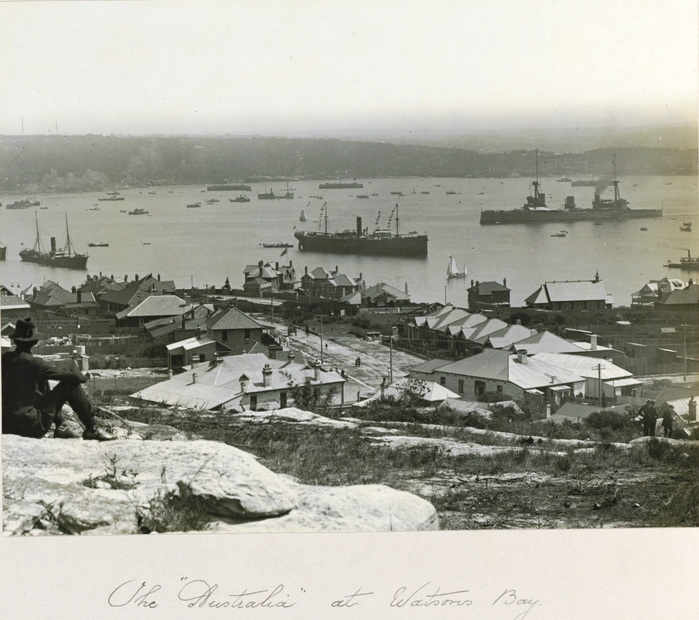
Image No. a3291049 from Album 62: Photographs of the Allen family, 11 May 1913 - 15 October 1913, courtesy State Library of NSW
THE WELCOMING PARTY. FEDERAL LEGISLATORS. Among those aboard the Kubu, the boat chartered by the Federal Government, were the Prime Minister (Mr. Joseph Cook) and Mrs. Cook, the Minister of Defence (Senator Millen) and Mrs. Millen, the Minister for Customs (Mr. Groom) and Mrs. Groom, Mr. W. H. Kelly (Honorary Minister), Mr. A. Fisher (leader of the Federal Opposition), Senator Pearce (ex-Minister for Defence), Mr. W. M. Hughes (ex-Attorney-General) Commander Pethbridge, Commander Brownlow, Senators Maughan, O'Keefe, Givens, M'Dougall, Gould, Turley, Gardiner, Story, Nowland, J. J. Long, and Barnes, Messrs. J. E. West, Conroy, Massy, Greene, D. Watkins, R. Patten, Abbott, Thomas, J. Stumm, Matthews, Anstey, A. ?ynton, Pigott, Archibald, E. S. Carr, R. Howe, M'Wllliams, Ahern, J. A. Boyd, L. Atkinson, W. Kendall, A. Chapman, J. Fenton, Rodgers, Pigott, Maloney, J. H. Catts, Bam-ford, Sharpe, W. E. Johnson, F. Brennan,Amery, Sir J. Henniker Heaton, Mr. L. S. Amery, M.P. (British House of Commons), Colonels Ryrie, M.P., K. Mackay, Ryan, Flascial, Kyngdon, Meesrs. A. B. Piddington (interstate Commissioner), H. E. Pratten (pre- sident of the Chamber of Manufactures), W. G. Layton (Deputy Town Clerk), W. H. L. Smith, C. H. Getting, J. Ryan, T. W. Henry, O. Albert, Randolph Bedford, Osmond J. M'Dermott, F. W. Berne, O'Donoghue, A. Eastwood, J. H. Fawcett, J. J. Herlihy, J. R. Wal lace, H. H. Fanston. W. F. L. Bailey, W. Arnott, A. W. O'Connor, G. Forbes, P. W. Berne, W. F. Finlayson, D. Maughan, L. Long, Davies, J. W. Clarke, M'Leod, D. H. Ross. C. B. Boydell, W. J. Boydell, G. Upward, G. C. Gillespie, J. J. Poynton, W. M'Leod, A. C. Palmer, W. A. Gale, T. Temperley, F. M. Gelattly, W. Charlton, Edmondson, F. Hayes, G. A. King, J. Lane Mullins, B. J. Grogan, A. Mar tin, F. Barnes, J. Arthur, A. Lyle, Beaver, A. C. Palmer, W. J. Purden, T. Courtney, J. T. Gilday, Millett, R. L. Nash, S. Wilmott, R. J. Drummond, J. W. Cleary, Lucas, Herman, W. B. Griffin, and Stanley, Rev. R. Heffernan, Alderman C. T. Clarke, Evan Jones, J. G. Griffin W. J. Walker, Laurence, J. Fitzgerald, W. J. Cox, T. H. Barlow, W. P. M'Elhone, Gilpin, Sancy, R. Harris, M. Bourke, M'Gree, Lindsay Thompson, J. English, and W. P.Fitzgerald. THE WELCOMING PARTY. (1913, October 6). The Sydney Morning Herald (NSW : 1842 - 1954), p. 6. Retrieved from http://nla.gov.au/nla.news-article15455497
ON BOARD THE HUNTER. A BROADSIDE OF SONG. A gay crowd of several hundred people boarded the steamer Hunter, reserved for the State's guests. Many prominent Government officers were present, including Mr. Coghlan (Chief Under-Secretary), Mr. Fotheringham, Mr. Percy Hunter, and Mr. d'Arcy (Secretary Navigation Department). One or two odd members of Parliament also found their way aboard. The passage to the Heads was enlivened by songs from the Leichhardt Public School Choir, under Mr. Newell, and by selections from the Public Schools Brass Band, under Bandmaster Bourke. The musical arrangements generally were in the hands of Mr. W. Bethell, Clerk in Charge of the Education Department. The Hunter's passengers had a fine view of the incoming fleet. They arrived at the Heads at about 10 o'clock, the grey, ghost-like line of ships then being about six miles out. There was no wild enthusiasm aboard the Hunter. The scene was rather one of impressive silence. Everyone was watching intently and thinking hard. It was not till the Australia was within hailing distance that the guests broke into a cheer, which was responded to by the officers on the warship gravely saluting. The Hunter paid each warship in turn the compliment in the same grave fashion, and in each case it was as gravely returned. The privileged boats followed in the wash of the fleet to its anchorage, and, when the Hunter got abreast she halted while the choir sang "Advance, Australia Fair." It was a broadside of song, and sounded well in the open space. ON BOARD THE HUNTER. (1913, October 6). The Sydney Morning Herald (NSW : 1842 - 1954), p. 6. Retrieved from http://nla.gov.au/nla.news-article15455498
ON THE CAPTAIN COOK. The pilot steamer Captain Cook was reserved almost exclusively for members of Parliament and their wives. Numerous members of both Houses availed themselves of the invitation which was orally issued by the Speaker of the Legislative Assembly and President of the Legislative Council respectively on Friday evening. Among those present were the Premier (Mr. Holman), Mrs.Holman, and Miss Kidgell, the Minister forWorks and Mrs. Griffith, the Minister for Edu-cation and Mrs. Carmichael, the Minister for Mines and Mrs. Edden, and the Vice-President, of the Executive Council and Miss Flowers. The Captain Cook steamed to the Heads to meet the fleet, and they joined in the pro-cession at the rear of the last destroyer. ON THE CAPTAIN COOK. (1913, October 6). The Sydney Morning Herald (NSW : 1842 - 1954), p. 6. Retrieved from http://nla.gov.au/nla.news-article15455489
THE FORESHORES. CROWDS AT VANTAGE POINTS. The populace turned out in their tens of thousands to accord a fitting welcome tothe fleet, and every headland was occupied by crowds, tensely alert, awaiting the ships. Ferry steamers moved slowly to and fro, also waiting, each packed with people. There was a big assemblage on South Head, every tram and boat for Watson's Bay from early morning being crowded to its utmost capacity. All round the Gap and beyond it spectators with their eyes strained seaward lined the cliffs, forming a living link, and had a magnificent view of the approach of the fleet from sea. All the head-lands on the northern side of the harbour were thickly thronged, and there would have been many more on Bradley's Head, George's Head, and other points, had the tram service been able to cope with the traffic and carry all who wanted to go there. As it was hundreds of North Sydney people gave up hope of getting to these reserves, and came over to the city side instead.
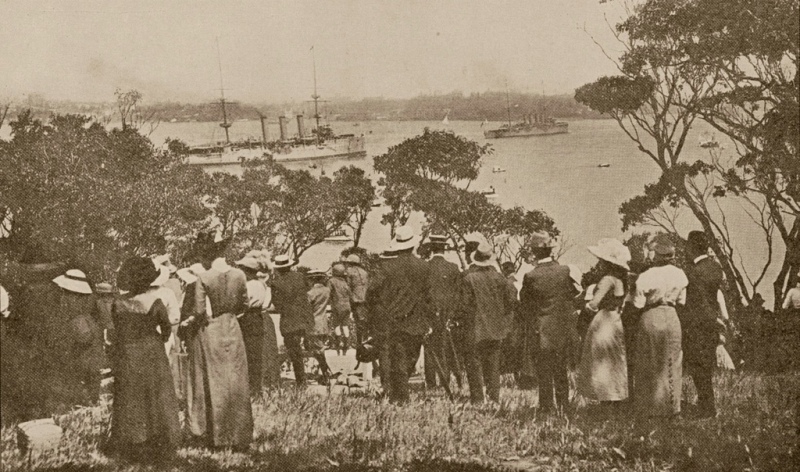
Oct 4, 1913: Spectators on Bradley's Head watch the RAN's first Fleet Entry into Sydney Harbour - HMAS AUSTRALIA and HMAS MELBOURNE [I] have just passed from view, HMAS SYDNEY [I] can be seen in the middle of the Harbour [right], with HMAS ENCOUNTER closer to the shore. Photographer unknown; appeared in a View Publications Pty Ltd booklet 'Warships in Australian Waters' [Sydney 1984] p29.
There were spectators all along both sides of the harbour, one of the most popular vantage points being Mrs. Macquaries Chair, which commands an extensive view of the waterway and Garden Island. The "Chair" was packed with people. Another favourite spot for sightseers was the Government House grounds, and the slopes of the adjoining Botanic Gardens also accommodated large numbers; while huge crowds swarmed along the sea-wall of Farm Cove.
Anticipating that a fine view of the approaching ships would be obtained from the many points along the coast toward Botany Heads, great numbers took up positions on Ben Buckler and the cliffs of Bondi, Bronte, Coogee, Maroubra, and Long Bay. The ships, however, instead of steaming up the coast, had gone out to sea, and entered the Heads from an easterly direction, and so those south of South Head got only a distant view.
Large crowds of sightseers gathered in the Botanic Gardens and Government House grounds yestorday, where a fine view of the crowded warships was obtained. The Sydney Professional Band, which was accommodated on a special stand in the latter grounds, played a number of selections during the afternoon. . THE FORESHORES. (1913, October 6). The Sydney Morning Herald (NSW : 1842 - 1954), p. 6. Retrieved from http://nla.gov.au/nla.news-article15455493
CROWDS AFLOAT. Thousands of people were afforded an excellent view of the procession of warships up the harbour from the decks of ferry and other boats, most of which took up positions between George's Head and Bradley's Head. Excitement ran high when the flagship and her consorts came within batting distance, and cheer upon cheer rose from the occupants of the watching boats. Some of the boats were provided with bands, which rendered patriotic airs, "Rule Britannia" being the favourite.
The ferry boats provided a most animated spectacle. Everyone was intent on seeing the most of the warships, and, consequently, some of the ferries had a very decided "list.' People were perched precariously on the bontorails, on the backs of seats, and, in fact, on anything from which they considered they could get a better view than from the decks. No whistles were, by request, sounded till the warships came to anchor. The moment this operation was over a crowd of little craft, released from the shores, launches, motorboats, and skiffs, raced over to the warships loaded with passengers. Every boat that had a whistle blew a more or less shrill "cocka-doodle-doo," people cheered loudly, hats were waved vigorously, and handkerchiefs fluttered in the breeze. All the motor boats and other small craft were packed to their licensed capacity, and their passengers sent forth cheers. CROWDS AFLOAT. (1913, October 6). The Sydney Morning Herald (NSW : 1842 - 1954), p. 6. Retrieved from http://nla.gov.au/nla.news-article15455500
VENETIAN CARNIVAL. POSTPONED TILL TONIGHT. The Venetian carnival, which was postponed on Saturday owing to the rain, will be held at Farm Cove this evening. The arrangements made for Saturday will be followed in all particulars. The boats will meet in the Cove at7.30 p.m., and be illuminated at 8 o'clock. During the evening the University Glee Club will give a musical programme. The Harbour Trust has placed at the disposal of the club the steamer Dayspring. VENETIAN CARNIVAL. (1913, October 6). The Sydney Morning Herald (NSW : 1842 - 1954), p. 6. Retrieved from http://nla.gov.au/nla.news-article15455494
OFFICIAL VISITS. Immediately after the Australia was moored in Farm Cove Admiral Sir George Patey paid an official visit to Admiral Sir George King- Hall on the Cambrian, and the latter immediately returned the visit to the Australia. On each occasion the visiting Admiral was received by a guard of honour. The greetings of the admirals was, however, a most significant event, for it marked officially the occasion around which all the day's celebrations were centered, viz., the transference from the Imperial authorities to the Commonwealth Government of the Australian naval station.
Admiral Patey then called at Admiralty House, where he was received by the three members of the Naval Board who were in Sydney, Senator E. D. Millen (Minister for Defence),chairman of the board; Admiral Sir W. R. Creswell, First Naval Member; and Captain H. W. E. Manisty, Paymaster-in-Chief and secretary to the board. The Admiral was presented by the board to the Prime Minister, who in turn presented the Admiral to the Governor-General. Admiral Patey then left Admiralty House, and paid a formal call on the State Governor and Lieutenant-Governor. He subsequently returned to Admiralty House, where he was entertained at luncheon by Admiral Sir George King-Hall. OFFICIAL VISITS. (1913, October 6). The Sydney Morning Herald (NSW : 1842 - 1954), p. 6. Retrieved from http://nla.gov.au/nla.news-article15455496
While all these were calling greetings from on water, on Garden Island, still Sydney Harbour's and the east coast of Australia's principal RAN naval base:
GARDEN ISLAND. THE SOCIAL SIDE. Garden Island, the picturesque little spot in the harbour that for so long has been associated with the navy, decked itself out in all its finery to greet the Fleet. Flags fluttered everywhere, and from the signal tower on the hilltop stretched long lines of bunting. And in place of the everyday blue of thesailors' uniforms, there were seen the bright and beautiful colours of ladies' dresses, adding an unwonted touch of gaiety to the island.
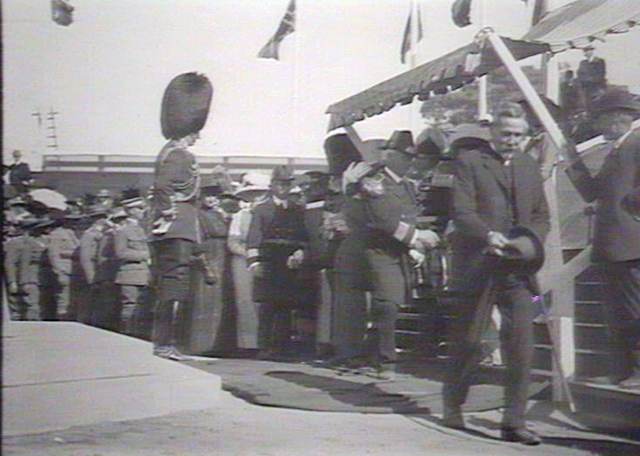 Here the social side of the day's doings was made manifest. On the little eminence that crowns the island were congregated the wives and daughters and sisters and cousins of the officers of the Australian Navy. With them were the officers of the Naval Brigade and the Naval Reserves, and the officers of the Garden Island depot. And there were also present a large number of military officers, paying their tribute to the other arm of the service. Down on the path that circles the island were drawn up the O.J. Brigade, 70 strong, fighting their battles over again, and adding their benison to the new navy. And most hopeful sight of all-near by was the Young Brigade, 650 Naval Cadets, lined up to salute their Admiral and their warships.
Here the social side of the day's doings was made manifest. On the little eminence that crowns the island were congregated the wives and daughters and sisters and cousins of the officers of the Australian Navy. With them were the officers of the Naval Brigade and the Naval Reserves, and the officers of the Garden Island depot. And there were also present a large number of military officers, paying their tribute to the other arm of the service. Down on the path that circles the island were drawn up the O.J. Brigade, 70 strong, fighting their battles over again, and adding their benison to the new navy. And most hopeful sight of all-near by was the Young Brigade, 650 Naval Cadets, lined up to salute their Admiral and their warships.Picture to right ' At The Reception for the Navy, Sydney Harbour, October, 1913. Picture courtesy State Library of NSW.
As the flagship and her consorts swung past Bradleys Head and glided gracefully up the harbour (the Australia wreathed in the smoke of her saluting guns), the blue line on the fringe of the island sprung to attention. There came the order "fix bayonets," and with a musical clatter the gleaming steel points were adjusted. Naval Reserve, Naval Cadets, the old Naval Brigade, and the veterans stood ready, and as the flagship drew level with the Island, Commander Dunn gave the order "Naval guard, present arms." Like clockwork the line came to the salute, the bugles blared, and the Naval Brigade Band played "Rule Britannia." Like an echo came the answering bugle from the Australia, as, dipping her flag, she proceeded to her moorings in Farm Cove. Each warship in turn passed the island.
OFFICERS AT HOME.
The main spectacle being over, the officers of H.M.A. Naval Yard and H.M.A.S. Penguin entertained several hundred guests on the island. Two large marquees were erected on the hill, and refreshments were dispensed tothe guests. Amongst the guests were Sir Wm. and Lady Cullen, the Inspector-General of Police and Mrs. Day, Mr. Joynton Smith.M.L.C., and Mrs. Smith, Mr. and Mrs. C. C.Lance, Mr. and Mrs. T. H. Keele, Mr. and Mrs. H. D. Walsh, Capt. and Mrs. Newton, Capt. and Mrs. Cummings, Miss Hilda Vining, Mr. and Mrs. Shearston, Mr. and Mrs. Hixson, Dr. and Mrs. Purdie, and a large number of civilians.
Amongst the naval officers present on the Island were: Captain Henderson, Engineer-Commander and Mrs. Bromwich, Engineer-Commander and Mrs. Druson, Engineer-Com-mander Amor, Commander and Mrs. Dunn,Staff-Paymaster and Mrs. Hoare, LieutenantGraham, Lieutenant Jones, Lieutenant Deane,Engineer-Lieutenant and Mrs. McEwen, As-sistant-Paymaster and Mrs. Peck, Staff-Pay-master and Mrs. Norton, Mrs. and Miss Brownlow, Lieutenant and Miss Brucegirlde, Lieutenant and Mrs. Fernley, Lieutenant andMrs. Spain, Lieutenant and Mrs. Lambton, Lieutenant and Mrs. Coggins, Lieutenant and Mrs. Black, Lieutenant and Mrs Read, Lieu-tenant and Mrs. Murnin, Fleet-surgeon andMrs. Francis, Captain and Mrs. Goldsmith,Captain McAuliffe, Chaplain and Mrs. FosterHaire, Chaplain and Mrs. Stewart, Fleet-surgeon and Mrs. Beatty, Fleet-paymaster and Mrs. Treacy, Fleet-paymaster and Mrs. Mart-in, Lieutenant and Mrs. Hine, Captain andMrs. Lamb, and Captain Elliott. The military officers included Colonel Wallack, State-Commandant, Lieutenant Colonel Luscombe, Lieutenant-Colonel White, Major Darval, Lieutenant-Colonel Antill, Major Holman, Lieutenant-Colonel Kyngdon, Major Murphy, Major Osborne, Captain Sherban, Major Hurst,Captains Brown, Brosnan, Bushell, Bilton,Williams, Conway, Smith, Sweetland, Cross,Watson, Mason, Major Brown, Colonel Lister,Major Wilkinson, Colonel Lee, Major Boam,Major Heritage, Colonel Bartlett, ColonelCooke, Colonel Holmes, Colonel Campbell,Colonel Kirkland, Lieutenant-Colonel Lenehan, Lieutenant-Colonel Pearce, Captain Mac-naghton, Major Spain, and Major Christian. Near the naval stores a special marque hadbeen erected, and here the navy and army veterans, under Captain W. H. Head, were entertained. The Citizen Naval Forces, under Lieutenant Fearnley, then embarked on the Ripple and were transported back to Rushcutters Bay. GARDEN ISLAND. (
1913, October 6).
The Sydney Morning Herald (NSW : 1842 - 1954), p. 6. Retrieved from
http://nla.gov.au/nla.news-article15455499
Saturday morning, 4th of October 1913, gave way to Saturday night:
BY NIGHT. THE CITY ILLUMINATED. Let it be admitted at the outset that there was an element of disappointment in the first night's illuminations of the city in honour of the home-coming of the fleet. This was due not to the citizens themselves, but to the thunderstorm which broke over the city early in the evening. Just at the hour when tens of thousands of citizens were about to leave the suburbs, the clouds which had been banking up during the afternoon rolled over the metropolis. Peals of thunder followed lightning flashes, and rain came down heavily. It looked most inauspicious for the evening's jubilations.
But the storm passed over. The moon emerged from the clouds. The stars shone. There was a belated rush to the city, and tens of thousands of citizens thronged the streets in holiday mood, enjoying the illuminations. And though the crowds were dense in the main thoroughfares, at Circular Quay and in the Domain it was yet possible to get about and see things. The thunderstorm had cleared the air, and those that came into the city were glad they did so. The illuminations, while not being on a particularly lavish scale, were worthy of the occasion. The city was embellished with myriads of coloured lights and lanterns. Sydney decked herself in jewels to welcome her sailors.
Circular Quay on an ordinary Saturday night is a semi-circle of lights, with the ferry boats gliding in and out, casting shimmering reflections across the waters. But on this occasion it was a night to remember. The old familiar background of the city lights assumed a new and varicoloured brilliance. The ferry wharfs were linked together with lines of light. First of the illuminations to greet the eye was the artistic display of the Sydney Harbour Trust. Facing the Quay was a huge silver star, below which, on an azure shield, was the well-known Southern Cross and the seal of the Trust picked out in red and white lights. The Customs-house had its outlines picked out in electric light, and above the clock there shone the welcome "Greeting to Fleet." Up Phillip-street aband was playing "The Star Spangled Banner" and the thoughts of many reverted to the occasion a few years back when the citizens welcomed the Great White Fleet from America.
All round the Quay the buildings were brightly illuminated. At Fort Macquarie the tram depot gave a pleasing touch of colour to the scene. A huge shield in the Southern Cross was outlined in the tricolour, and across the front of the building facing the sea was "Welcome" in huge letters. On the other side was the Union Jack surrounded with stars. At the entrance to Government House grounds, near Man-o'-War steps, once more was emblazoned the prevailing "Welcome." George-street was pretty much like the Great White Way of New York would be if coloured. In the bright light the flags and bunting could be seen clear as day. All the buildings along the street to the railway added a splash of colour or a blaze of lights to the picture. First came the Fire Station, ablaze with colour. The Royal Naval House in Grosvenor-street made a pleasing display with coloured lights, and here many of the naval men found a welcome.
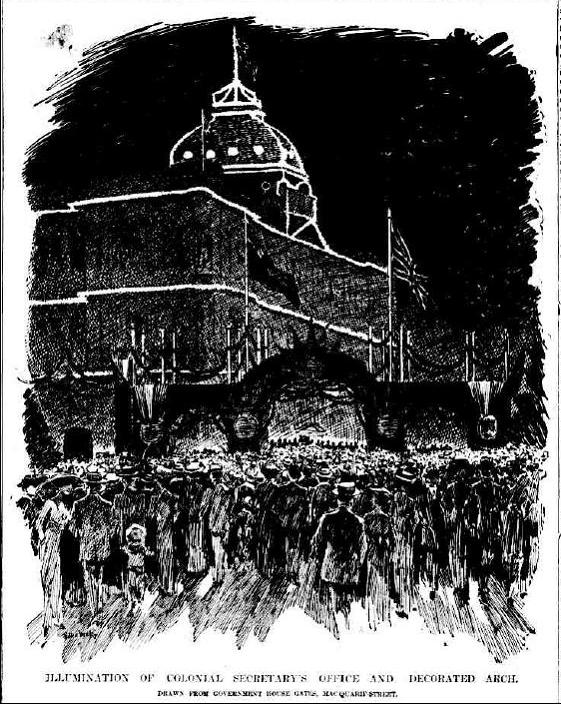 Martin-place is recognised now as the show thoroughfare. At the corners of George-street and Pitt-street the four white pillars were picked out with pink lights, and connected with silver strands, the effect being really artistic. The General Post Office made an imposing spectacle, outlined in electric light, with a special blaze focussed on the frontstatuary, and long lines of white lights fromthe tower to the cornors. Another very effective display was that of the Town Hall, probably the most ambitious of all the Illuminations. The lines of the civic edifice were allmarked with lines of light. Long strands ofelectric light stretched from the portico tothe tower. Here a fine printed star in co-lours looked most artistic, while on either side were huge letters showing the royal "G.B." George-street here was as light as day, and theflags added more colour to the scheme. Opposite the Town Hall was another effective colour display.
Martin-place is recognised now as the show thoroughfare. At the corners of George-street and Pitt-street the four white pillars were picked out with pink lights, and connected with silver strands, the effect being really artistic. The General Post Office made an imposing spectacle, outlined in electric light, with a special blaze focussed on the frontstatuary, and long lines of white lights fromthe tower to the cornors. Another very effective display was that of the Town Hall, probably the most ambitious of all the Illuminations. The lines of the civic edifice were allmarked with lines of light. Long strands ofelectric light stretched from the portico tothe tower. Here a fine printed star in co-lours looked most artistic, while on either side were huge letters showing the royal "G.B." George-street here was as light as day, and theflags added more colour to the scheme. Opposite the Town Hall was another effective colour display.
Macquarie-street, the official quarter of the city, attracted large crowds. At the harbour end could be seen high in the heavens the redlights that outlined the tower of the Chief Secretary's Office, the rest of the edifice beinglit up with white electric lights. The arch at the main entrance to Government House grounds was brightly illuminated, and in the Inner Domain the band rotunda was picked out like a tent of white light. Parliament House had the Empire flags surrounded with electric globes, the balconies and front all being il-luminated. At the southern end the Queen's Statue was set in a forest of palms, and surrounded by circles of red and white lights.The front of St. Mary's Cathedral, visible from the harbour, had a huge Southern Cross in white, while the Registrar-General's Offices had its lines picked out in white, with red and yellow lights giving colour to the Pitt-street, from its narrowness, seemed inperspective to be just a long line of flickeringlights. The new A.M.P. building had a golden crown within a shield, and the motto, "Welcome to the Fleet." The "Herald" office, outlined on three sides with electric globes, had in front the Empire-flags and a welcome greet ing. Offices and shops along the street added their quota to the scene. The Culwulla sky-scraper, with its coloured globes, could be seen from the eastern suburbs. In Oxford-strect and Broadway were more illuminations, and right out to the suburbs could be seen the blazing lights of welcome. BY NIGHT. (
1913, October 6). The Sydney Morning Herald(NSW : 1842 - 1954), p. 6. Retrieved from
http://nla.gov.au/nla.news-article15455477
Sunday the 5th of October 1913
On Sunday there will be an official church parade and an afternoon service in the Town Hall for the men. The attractions on Monday are -Vessels open for inspection in the morning, Eight Hours demonstration and sports, A.J.C. Spring Meeting officers' theatre party and city and fleet illuminations. In the evening on Tuesday there will be a march through the city and an at home on the Australia, a ball at Government House and illuminations. The celebrations will be continued on Wednesday, Thursday, Friday, and Saturday. WELCOMING THE FLEET. (
1913, October 4).
The Argus(Melbourne, Vic. : 1848 - 1957), p. 19. Retrieved from
http://nla.gov.au/nla.news-article7290558
Monday 6th of October, proclaimed an Eight Hours holiday:
ROYAL NAVAL HOUSE. ACCOMMODATES 743 MEN.
The Royal Naval House in Grosvenor-street on Saturday evening presented an interesting sight. Special efforts were made to decorate and illuminate the building, and the work of Superintendent Shearaton and his men is deserving of special mention. The Royal Naval House has 400 beds, and in addition 34 stretchers that can be brought in house. But the Superintendent was called on to make provision for the largest crowd of naval men who have ever put up in the building for one night. His staff found rugs, blankets, and mattresses for an additional 209 men.
"Excellent," said Mr. Shearaton, referring to the conduct of the men. "I have had many years' experience amongst naval men, and I must say that, the behaviour was splendid. We called the men at 6 o'clock on Sunday morning, and in 25 minutes the whole of the 743 men were up, washed, and dressed, and on their way to their ships.
Admiral King-Hall was very solicitous as to the men's welfare, and was in communication with the superintendent both on Saturday evening and Sunday morning.
Tonight there is to be a social evening and dance when the men will be allowed to invite a lady friend. Tomorrow evening there is to be a special performance of national music by the State Military Band, under the direction of Captain W. G. Bentley. The men may invite their friends for the recreation room or the balconies. ROYAL NAVAL HOUSE. (1913, October 6). The Sydney Morning Herald (NSW : 1842 - 1954), p. 6. Retrieved from
http://nla.gov.au/nla.news-article15455475
1913 was the Year of the Tango all over the world and everyone was either dancing these steps or learning how to. Traditional waltzes, white gloves, fruit punches and generous suppers after a day on or beside the harbour, it must have been a wondrful week:
THE FLEET. A BUSY DAY. BRILLIANT WATER SCENE. CROWDS ASHORE AND AFLOAT.
Nothing untoward marred the holiday festivities yesterday (Monday 6th of October, 1913) in connection with the welcome of the Australian section of the Royal Navy. There was a general desire manifested to visit the warboats, especially the flagship, the Australian, and from early forenoon till late in the afternoon she was boarded by throngs of visitors. The Australia needed to be a stout ship to carry the surging cargo of humanity that swarmed about her like myriad bees clustering round a hive, but her great width of beam made her equal to the multitudinous nature of the day's call.
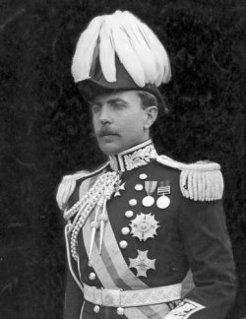 Left: Lord Thomas Denman (1874-1954), by unknown photographer, 1910s. nla.pic-an23334619, courtesy National Library of Australia.
Left: Lord Thomas Denman (1874-1954), by unknown photographer, 1910s. nla.pic-an23334619, courtesy National Library of Australia.Admiral Patey received some distinguished visitors in the morning. Just before noon Lord Denman paid the Australian Admiral a return visit. The Governor-General was accompanied by Sir Walter Barttelot, Commander Brownlow, and Colonel Wallack, CB. (the State Commandant). His Excellency was received by a guard of honour. Having paid his respects to the head of the fleet, his Excellency left the flagship to the accompaniment of a salute of 19 guns.
The State Governor, Sir Gerald Strickland, also paid the Admiral a return call. His Excellency was accompanied by Major-General Finn (Private Secretary), and Captain Talbot, A D.C. Sir Gerald Inspected the guard of honour, and left the ship amid the salvos of the customary 17-gun salute. The Minister for Defence, Senator Millen, also paid Admiral Patey an official call. The Minister was accompanied by Rear-Admiral Creswell, first naval member of the Naval Board.
The ship illuminations during the evening attracted many thousands. Government House grounds made an ideal amphitheatre, and the spacious reserve was literally alive with people. The scene on the harbour was one of transcendent beauty, which reached a fitting climax when the men-of-war emblazoned foreshores and harbour with the effulgence of their searchlights. The Venetian carnival was quite pretty. The city illuminations attracted large crowds of pedestrians, Macquarie-street particularly being a favorite thoroughfare The ornate display of lights on the Customs house, and the artistic tracery along the tower and facades of the Chief Secretary's office, were especially admired. During the evening the sailors of the fleet enjoyed themselves at the Royal Naval House, where dancing was kept up till the small hours of this morning. THE FLEET. A BUSY DAY. (
1913, October 7).
The Sydney Morning Herald (NSW : 1842 - 1954), p. 5. Retrieved from
http://nla.gov.au/nla.news-article15455687
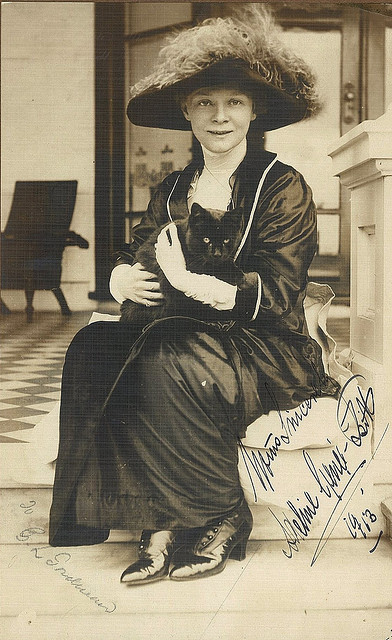 AT THE THEATRE. NAVAL OFFICERS ENTERTAINED
AT THE THEATRE. NAVAL OFFICERS ENTERTAINEDLast evening was Navy Night at Her Majesty's Theatre. The place was packed to the doors, and the utmost enthusiasm was manifested throughout the evening. The theatre was gaily decorated with flags and bunting, the Australian flag having pride of place in the centre of the circle, where the Minister for Defence and the Admirals were seated. Mile. Genee delighted the audience with her brilliant performance in "Coppolia," and was rewarded with several beautiful bouquets and a special souvenir of the fleet, signed by Admiral Patey. As an extra, appropriate to the occasion, Mile. Genoe contributed a sailor's hornpipe, with a huge Commonwealth flag for a background, and this item was responsible for a veritable furore, the diva being recalled again and again until she had repeated the Item. Miles. Hallna, Schmolz, and Novotna, and M. Voilnin, also contributed to the evening's enjoyment. The evening was given by the officers now on the station to the officers of the Australia and Sydney. About a hundred officers were present, their uniforms adding to the picturesqueness of the scene. Those present included the Minister for Defence and Mrs. Millen, Rear-Admiral Sir G. Patey, Rear-Admiral Sir Wm. Cresswell, Senator and Mrs. Pearce, the Premier (Mr. Holman), Captain Glassop, Captain Drummond, Captain Silver, Captain Carr, Captain Gordon Smith, Flag-captain Radcliffe, Flag-Lieut. Rodham, Engr.-Cr. Bromwich, Flag-Surgeon Beattie, Commander Brownlow, Commander Lewin, and Engineer Lieut. M'Ewen. AT THE THEATRE. (
1913, October 7).
The Sydney Morning Herald (NSW : 1842 - 1954), p. 5. Retrieved from
http://nla.gov.au/nla.news-article15455671
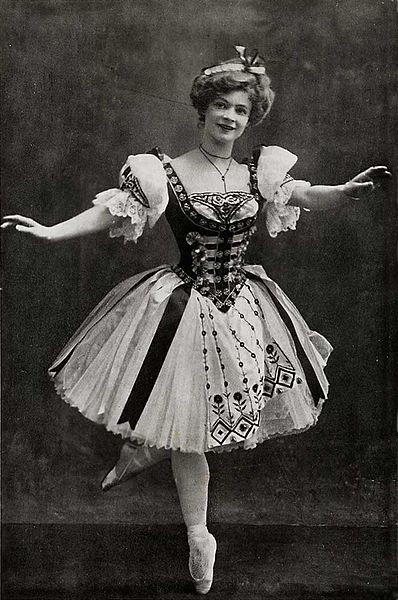 Left: Danish ballerina Adeline Genee, Sydney, 1913 / photograph by May & Mina Moore Right: Adeline Genée as Swanilda in Coppélia, London, 1900
Left: Danish ballerina Adeline Genee, Sydney, 1913 / photograph by May & Mina Moore Right: Adeline Genée as Swanilda in Coppélia, London, 1900
The lady spoken of in the above article was considered the best ballet dancer in the world at this time. Dame Adeline Genée, as her name is spelt elswhere. The photograph inserted here (below) of her is from the Allen Family album, the people who brought
Dame Melba out to Bilgola for Lunch and also entertained this dancer when she vsiisted Australia in this auspicious year. :
BALLET FOR AUSTRALIA. A COMPANY ENGAGED. LONDON, March l8. Mr. J. C Williamson has engaged Madame Adeline Genee, the well-known dancer, and a full ballet company for an Australian tour winch is to open on, June 21. The engagement of Adeline Genoe, the world's greatest dancer, by Mr. J. C. Williamson, for a season in Australia, is the result of prolonged negotiations carried on by Mr. George Tallis, during his visit to New York in December last, when the great dancer was appearing at the Metropolitan Opera House in that city, supported by two of her famous dancers, M.Volinin and Mille. Schmolz, with a full corps de ballet from the Imperial Opera House, St. Petersburg. There were at first many difficulties in the way of a. successful outcome of the negotiation- It was not a -question of money, for Madame. Genoe is a rich woman, and exceptionally high and tempting terms were offered by J. C. Williamson in Russia. It was a question at the time whether the Czar of Rus-sia, whose permission had been given to allow of M. Volinin and Mile. Schmolz and the Imperial ballet appearing in New York would consent to extending their terms abroad to enable a visit to Australia taking place. These obstacles, however, were removed, and Madame Genoe was to have her desire to visit a country concerning which she had heard a great deal from Madame Melba, who advised her to add Australia to her itinerary. The season, which will comprise twenty weeks, will commence at Her Majesty's Theatre, Melbourne, next June, and the entire company will be transferred to Australia, the programme being exactly the same as presented at the Metropolitan Opera House, New York, in December last. It will include, in addition to M. Volinin and Mile. Schmolz, who are two of the most important principals of the Imperial Russian ballet at St. Petersburg, other prominent Russian dancers, and a full corps de ballet. Madame Genoe will be seen in her most famous dances, including "Dryad." "La Sylphide," "The Arabian Nights," "Coppellia," and others. BALLET FOR AUSTRALIA. (1913, March 20). The Advertiser(Adelaide, SA : 1889 - 1931), p. 10. Retrieved from http://nla.gov.au/nla.news-article5384362
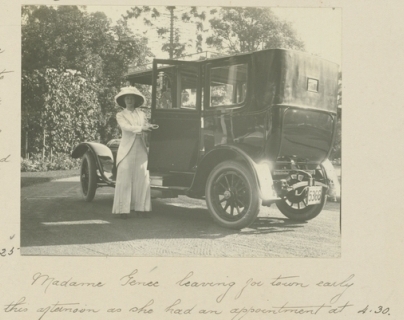 Sunday 5th of October, 1913 - Image No. a3291052h from Album 62: Photographs of the Allen family, 11 May 1913 - 15 October 1913, courtesy State Library of NSW
Sunday 5th of October, 1913 - Image No. a3291052h from Album 62: Photographs of the Allen family, 11 May 1913 - 15 October 1913, courtesy State Library of NSW
As with this year's International Fleet Review, people were invited to go aboard these new ships and learn more about them. The one most preferred to visit, unsurprisingly, was their brand new flagship:
ON THE FLAGSHIP. CROWDS OF VISITORS. OUT-OF-THE-WAY CORNERS.
Thousands of people explored the flagship yesterday- Though all the ships were open for inspection, it was the Australia that everyone wanted to see. A few went over the Sydney, but the Melbourne and the rest of the fleet had hardly any visitors. Everywhere about the Australia men, women, and children, strolled and clambered. They climbed every ladder that went upwards, and descended every bolo-that went downwards They penetrated the very bowels of the ship, 20 foot and more below the water… It was their battle cruiser, and they inspected It from top to bottom, and came away impressed with Its stupendous strength.
Over and over again the Australia has been described, and yet the half has not been told. The tale of her size, her guns, nor armour, her engines, must be familiar by now to all ordinary diligent readers of papers. There is no need to ever enter into further details In regard to these features. But there are a lot of little odds and ends of information that have not yet got into print. If you are a tall man you will have in making your way about the recesses of the ship to move about with head bent, for the spaces between decks are designed for men of medium height only. There is plenty of ventilation below. That, indeed, is one of the features of the modern man-o-war. Pumps distribute currents of air along windshafts to every point, and at times the breezes blow fresher than on deck.
OFFICERS AND MEN'S QUARTERS.
One of the things that strikes the visitor forcibly is the vast difference between the quarters of the officers and Its midshipmen, and the quarters of the men. In the one case there is ample elbow room, not to speak of furnishing and general conveniences; in the other, there is hardly space to move about. There is much murmuring among the men on this account.
THE MIDSHIPMEN. The midshipmen are aristocratic young gentlemen. There are 14 of them, all, as they Impress upon one, from "the Royal Navy." Some are disappointed with Sydney Harbour.
"I thought you would ask me that," observed one rather pretty boy, with golden curls surmounting a fresh-complexioned face, when a pressman Jocularly ventured an Inquiry as to his impressions of Sydney. A ripple of boyish laughter had gone around the gunroom. "we’ve had the beauties of Sydney Harbour dinned into us over since we Joined the ship, and expected that it would be a much finer place than it is."
. "In what way were you disappointed?"
"we thought It would be larger, and generally finer. Then, as first city-well, it looks finer from the outside than the inside!"
They are a nice lot of healthy looking, Intelligent boys, the makings of good officers. Just now they take themselves rather seriously, but that is characteristic of the "middy" everywhere. They will grow out of that by and bye. Two chameleons, presented to them at Durban, are the pots of the gunroom.
POLICE AND GAOL.
The ship is, when away from port, a separate cosmos with laws unto Itself, and the commander acts as a sort of magistrate, the captain who is In supreme command, hearing the more serious cases, and being the court of appeal. There are no marines on the Australia, but there are ship's police, whose duly it is, amongst other things, to check the lists of men on leave. At their bead is a master at-arms and four corporals. There is a gaol also. It contains five cells, and in each is to be found a Bible, so that an offender may get a little spiritual comfort, if he gets no physical comfort. The cells had two occupants yesterday, and there were two others awaiting trial, who were gazing wistfully through port- holes. They were compelled to remain within the precincts of the gaol, being guarded by a sentry. They will answer to the charges preferred against them-whatever they are to-day.
TELEPHONE SYSTEM.
There are telephones everywhere. In the noisy part of the ship they are In booths. They are on the bridge, In the control stations, the gun turrets, the offices, and even right down in the Stokehold. There are 14 of them altogether, and If one lifts a receiver and speaks there comes an immediate answer from the exchange, and connection with the number wanted. It is quite a revelation for an untravelled Sydney man to have this demonstration that it Is possible-to conduct al telephone system without the nerve-racking and profanity-producing experiences that happen to those who are compelled to use the city telephones. The common battery system is in operation, a light showing on the switchboard when a call is made. To-day connection will be established between the warship and the Sydney exchange by means of a cable from Man-o'-war Steps, and thus not only will one be able to get Into communication with the ship from Sydney and the suburbs, and those centres that are linked up with the city by telephone, but it will be possible to speak to and from Melbourne as well.
SICK BAY.
"Sick Bay" is the name by which the hospital of a warship Is known In the service. It seems In the case of the Australia to have been put In the noisiest part of the ship in the after-part, right under the guns. The "Herald" representative happened to drop In yesterday Just as a salute was being fired from the little three-pounders, and was satisfied that "Sick Bay" was no place to be in when big guns were barking. Not a day passes but some portion of the hospital accommodation is occupied by cases of sick- ness or accident, and as fast as the patients are discharged cured and well they are replaced by others. There are always on the "visiting list" of the ships' surgeons numerous cases of minor ailments and accidents which In themselves do not incapacitate their subjects from duty, but which require constant watching and attendance. The hospital is fitted with ten cots closely but conveniently arranged. An operating table, chests containing fully-equipped cases of all the most modern surgical Instruments and appliances, full supplies of bandages, wrappings, surgical dressings, and sterilising appliances are all to be found there. A room off the hospital Is used as a dispensary, and here, as In "Sick Bay" Itself, everything Is right up to date and absolutely spotless.
There is in connection with the hospital a steam disinfector, for the disinfection of the clothing and bedding of all men suffering from infectious diseases. This Is a matter of vital Importance, of course, in a crowded warship.
INSPECTING THE FLAGSHIP. 'ALL SORTS OF CRAFT .WERE USED TO CONVEY VISITORS TO THE 'AUSTRALIA ' YESTERDAY.
POST-OFFICE.
There is a post-office, which at present is handling the mails for the whole fleet. It is run just like any ordinary post-office, having three Inward and three outward mails a day. Yesterday 10 bags of mail matter, mostly from the old country, representing between 2000 and 3000 letters and newspapers for those on the ships, were sorted and delivered.
THE SHIP'S PRINTER.
There is a printing office aboard the ship. It is not a very large affair, but the plant, though small, is a good one. There are' a couple of frames, filled with cases of plain and fancy types, n "stone," and a treadle machine. The printer and a couple of assistants And plenty to do. There are official orders to be put into type, and official forms for the clerical and other staffs and menus to be printed, as well as occasional concert programmes.
OFFICERS' DUTIES AND PAY.
At the head of the ship is the Flag Captain. The Admiral. Is, of course, the supreme head, but not of the Australia alone, and no more of the Australia than of the Melbourne, Sydney, Encounter, or other ships. He happens to live aboard the Australia. That is all. The captain is the king of the Australia; the Admiral is the Emperor of the fleet. The captain's pay is £889 per year.
The commander handles the men. His position Is no sinecure. Not that the captain's is, but the commander has to be about everywhere, and at all hours. His pay is £593 per annum.
Then there Is the senior lieutenant, who is concerned with navigation only. Next to him is the first lieutenant, who is in charge of the men's deck and upper deck. There are three senior lieutenants, who do not keep watches. Each of the remaining lieutenants-the gentlemen one sees walking .about .with, telescopes under their arms, apparently more for ornament than for use-have definite charge of an army of workers, and keep watch in turn. The ordinary lieutenants get £373 per year, their pay rising to £410, with emoluments.
THE WARRANT OFFICERS.
Then are eight warrant officers-the gunner, torpedo gunner, boatswain, the carpenter, the signal boatswain, are some of them. They are responsible for all the stores on the ship. The carpenter turns his hand to a lot of things. He has to see that the decks, boats, guard rails, and stanchions are kept in repair. He is also the painter. The Australia gets eight coats of paint a year, and ho has to provide it. Fourteen hundredweight of white lead is required for each coat. Altogether about 20 tons of point are used on the Australia alone In a year. He also has to make the targets for practice at sea.
The gunner is responsible for the magazines and shell rooms, all the guns and fittings, and hydraulic gear, the signal boatswain for all signals, the torpedo gunner for all the electrical contrivances, motors, dynamos, wireless, and, of course, the torpedos as well. They are all highly trained experts in their particular lines.
THROUGHOUT THE AFTERNOON" THE DECKS OF, THE GREAT BATTLE-CRUISER ,WERE CROWDED WITH EAGER SIGHTSEERS.
SEAMEN AND STOKERS.
The seamen are up at 5.30 in the morning, and start work at 6 o'clock. They keep the ship clean, they polish up the brasswork, and' they drill-drill incessantly. Besides them there is an army of stokers; there are cooks, stewards, electricians, artisans of all kinds, and no end of miscellaneous ratings. There is also a band, which discourses music while the men are at breakfast, and for the officers while they are at dinner. They have little other work to do than to keep their quarters clean, and learn the latest rag-time airs.
THE SEARCHIJGHTS.
Finally, the searchlights. The Australia carries 16 of them disposed in pairs, and each of about 33,000-candle power. For display purposes they are manipulated on a system do signed to give a purely spectacular effect. For serious purposes trey are worked differently. Just one more bit of information picked up from an electrician. Fourteen hundred lamps are used for the interior illumination of the ship each night. ON THE FLAGSHIP. (
1913, October 7).
The Sydney Morning Herald (NSW : 1842 - 1954), p. 5. Retrieved from
http://nla.gov.au/nla.news-article15455676
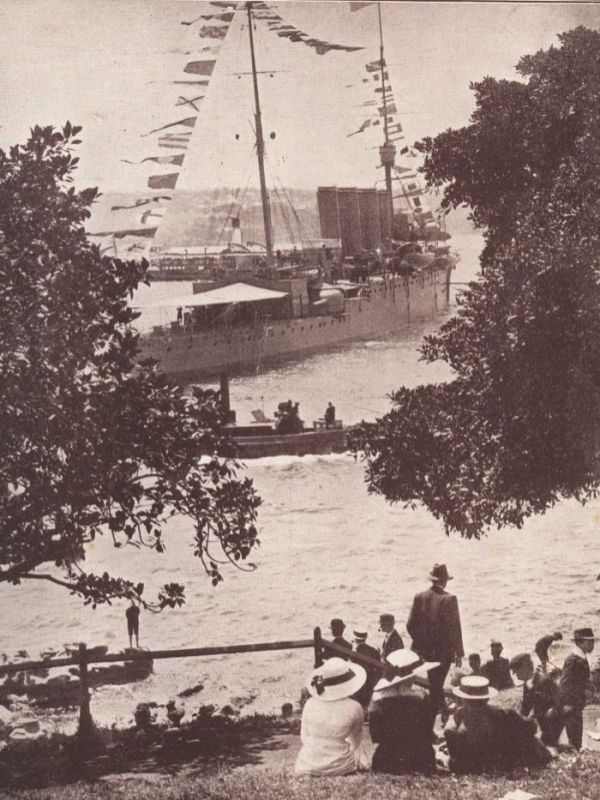 Tuesday 7th of October 1913:
Tuesday 7th of October 1913:
TODAY'S PROGRAMME. MARCH THROUGH THE CITY. Following is the programme for today's festivities:
10.45 a.m.-March through city, then will form up in old Government House grounds, then march, via Macquarie-street, Hunter street, Pitt-street, Martin-place, George street, Bathurst-street, Elizabeth-street, St. James-'road, College-street, Oxford-street, and Flinders-street, to Royal Agricultural Society's Grounds, Moore Park, where the whole party will be entertained at luncheon by the Federal Government. A map of .the route was published in yesterday's issue.
12.30 p.m.-Federal Government's banquet to men at Royal Agricultural Hall.
In the afternoon there will be an officers' "at home" aboard the Australia.
8 p.m. to 10 p.m.-A band will play in Hyde Park.
9 p.m.-Ball at Government House, at Rose Bay. Fleet Illuminations. TO-DAY'S PROGRAMME. (
1913, October 7).
The Sydney Morning Herald (NSW : 1842 - 1954), p. 5. Retrieved from
http://nla.gov.au/nla.news-article15455661
Wednesday 8th of October 1913:
Picture to right from Sydney Mail, published on 8 October 1913
Thursday 9th of October 1913:
AUSTRALIAN FLEET. CHILDREN'S DEMONSTRATION.
SYDNEY, Thursday - To day was special children's day in connection with the Australian fleet celebrations Some eight thousand school children joined in the demonstration on the Sydncy Cricket ground. It was a bright sunny day. When the children took up their places they represented the complete outline of the Australian continent, with a large star in the centre… AUSTRALIAN FLEET. (
1913, October 10). The Argus(Melbourne, Vic. : 1848 - 1957), p. 9. Retrieved from
http://nla.gov.au/nla.news-article7273055
THE AUSTRALIAN FLEET. Another Batch Entertained.
Another body of men from the Australian Navy was entertained by the Federal Government at luncheon at the Agricultural Grounds, Sydney, on Thursday. The men were drawn from the Australia (200), Sydney (100), Melbourne (100), Cambrian. (120), Encounter (80), Pioneer (30), and several from the Psyche, the destroyers, and the Tingira .
Senator Millen, the Minister for Defence, with Admiral Cresswell, welcomed the men on behalf of the Australian Government. He hoped that the festivities would compensate them for the monotony of the long voyage to Australia. At the call of Captain Gordon-Smith cheers were given for the Australian Government and Senator Millen. The school children's demonstration in honor of the Australian Fleet took place on Thursday on the Sydney Cricket Ground, and Young Australia's welcome to our defenders was very hearty. After the children had filed to the ground they were formed up in a mass in the centre with a single line of boys round the edge representing the points of a star. When Sir Gerald Strickland, the State Governor, arrived with Admiral Cresswell, the presentation of a silk flag was made by Mr. P. Board, Under-Secretary for Education, to a company of sailors from H.M.A.S. Australia on behalf of the school children. The flag was broken from a masthead by Lady Cresswell, and was greeted with tumultuous cheers. Then it was hauled down, and Mr. Board handed it to Lieutenant Euman, who was in command of the men from the Australia who had marched on to the ground.
Mr. Board said:, "It is the desire of the .children of the public schools of State, to show that they recognize the coming of the fleet as a great event in their country 's history. In every school in the land the story of the fleet has been told and heard with pride by many thousands of young Australians. To those young people the flag which they wish to present today stands for a national event which they heartily appreciate, and by its combination of the Union Jack with the Australian Stars it stands for a sentiment to which they cordially respond. I have the honor, on behalf of the schools of New South Wales, to ask your acceptance of this flag for His Majesty's ship Australia."
Lieutenant Euman replied in a few appropriate words. The giving of the flag was marked by a remarkable demonstration. The children waved their wands in the air, and the whole crowd in the ring was immediately covered with a wave of brilliant, color. " ' THE FLEET.
(1913, October 11).
Singleton Argus (NSW : 1880 - 1954) , p. 10. Retrieved from
http://nla.gov.au/nla.news-article80144714
Friday October 10th 1913:
THE FLEET. VISITORS FROM THE COUNTRY. SYDNEY. October 10.
Today 1,500 school children from country places visited the Australian Fleet in Sydney Harbour. They came from all parts of the State, some from Broken Hill. Many of them had not seen Sydney before. Nothing has been definitely arranged regarding the movements of the fleet at the conclusion of the reception' programme. THE FLEET. (
1913, October 11).
The Register (Adelaide, SA : 1901 - 1929), p. 15. Retrieved from
http://nla.gov.au/nla.news-article59103325
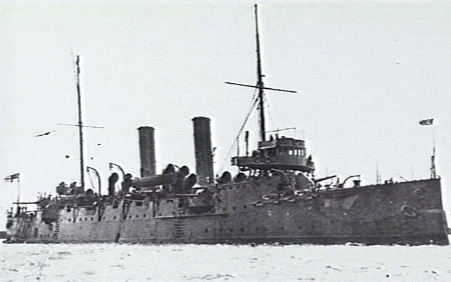 1910. STARBOARD BOW VIEW OF THE SECOND CLASS PROTECTED CRUISER HMS CAMBRIAN, THE LAST FLAGSHIP OF THE AUSTRALIA STATION. NOTE THE 6 INCH GUN ON HER FORECASTLE AND THE 4.7 INCH GUNS TRAINED ON THE STARBOARD BEAM AWM image 302155
1910. STARBOARD BOW VIEW OF THE SECOND CLASS PROTECTED CRUISER HMS CAMBRIAN, THE LAST FLAGSHIP OF THE AUSTRALIA STATION. NOTE THE 6 INCH GUN ON HER FORECASTLE AND THE 4.7 INCH GUNS TRAINED ON THE STARBOARD BEAM AWM image 302155
AUSTRALIAN FLEET. FESTIVIITIES ENDED.
SYDNEY, Sunday.-Saturday saw the conclusion of the celebrations in the welcome of the Australian fleet. The warships were again open for public inspection, and were visited by about 5,000 persons. Some 400 officers and men of the fleet attended the races at Randwick. Tomorrow work on the warships will be resumed. The Cambrian, which was the Imperial flagship until the arrival of the Australia, will leave Sydney tomorrow, homeward bound. AUSTRALIAN FLEET. (
1913, October 13).
The Argus(Melbourne, Vic. : 1848 - 1957), p. 10. Retrieved from
http://nla.gov.au/nla.news-article7258687
And at the end of this week - the 2013 Celebrations begin!!


 Here the social side of the day's doings was made manifest. On the little eminence that crowns the island were congregated the wives and daughters and sisters and cousins of the officers of the Australian Navy. With them were the officers of the Naval Brigade and the Naval Reserves, and the officers of the Garden Island depot. And there were also present a large number of military officers, paying their tribute to the other arm of the service. Down on the path that circles the island were drawn up the O.J. Brigade, 70 strong, fighting their battles over again, and adding their benison to the new navy. And most hopeful sight of all-near by was the Young Brigade, 650 Naval Cadets, lined up to salute their Admiral and their warships.
Here the social side of the day's doings was made manifest. On the little eminence that crowns the island were congregated the wives and daughters and sisters and cousins of the officers of the Australian Navy. With them were the officers of the Naval Brigade and the Naval Reserves, and the officers of the Garden Island depot. And there were also present a large number of military officers, paying their tribute to the other arm of the service. Down on the path that circles the island were drawn up the O.J. Brigade, 70 strong, fighting their battles over again, and adding their benison to the new navy. And most hopeful sight of all-near by was the Young Brigade, 650 Naval Cadets, lined up to salute their Admiral and their warships. Martin-place is recognised now as the show thoroughfare. At the corners of George-street and Pitt-street the four white pillars were picked out with pink lights, and connected with silver strands, the effect being really artistic. The General Post Office made an imposing spectacle, outlined in electric light, with a special blaze focussed on the frontstatuary, and long lines of white lights fromthe tower to the cornors. Another very effective display was that of the Town Hall, probably the most ambitious of all the Illuminations. The lines of the civic edifice were allmarked with lines of light. Long strands ofelectric light stretched from the portico tothe tower. Here a fine printed star in co-lours looked most artistic, while on either side were huge letters showing the royal "G.B." George-street here was as light as day, and theflags added more colour to the scheme. Opposite the Town Hall was another effective colour display.
Martin-place is recognised now as the show thoroughfare. At the corners of George-street and Pitt-street the four white pillars were picked out with pink lights, and connected with silver strands, the effect being really artistic. The General Post Office made an imposing spectacle, outlined in electric light, with a special blaze focussed on the frontstatuary, and long lines of white lights fromthe tower to the cornors. Another very effective display was that of the Town Hall, probably the most ambitious of all the Illuminations. The lines of the civic edifice were allmarked with lines of light. Long strands ofelectric light stretched from the portico tothe tower. Here a fine printed star in co-lours looked most artistic, while on either side were huge letters showing the royal "G.B." George-street here was as light as day, and theflags added more colour to the scheme. Opposite the Town Hall was another effective colour display. Left: Lord Thomas Denman (1874-1954), by unknown photographer, 1910s. nla.pic-an23334619, courtesy National Library of Australia.
Left: Lord Thomas Denman (1874-1954), by unknown photographer, 1910s. nla.pic-an23334619, courtesy National Library of Australia. AT THE THEATRE. NAVAL OFFICERS ENTERTAINED
AT THE THEATRE. NAVAL OFFICERS ENTERTAINED Left: Danish ballerina Adeline Genee, Sydney, 1913 / photograph by May & Mina Moore Right: Adeline Genée as Swanilda in Coppélia, London, 1900
Left: Danish ballerina Adeline Genee, Sydney, 1913 / photograph by May & Mina Moore Right: Adeline Genée as Swanilda in Coppélia, London, 1900 Sunday 5th of October, 1913 - Image No. a3291052h from Album 62: Photographs of the Allen family, 11 May 1913 - 15 October 1913, courtesy State Library of NSW
Sunday 5th of October, 1913 - Image No. a3291052h from Album 62: Photographs of the Allen family, 11 May 1913 - 15 October 1913, courtesy State Library of NSW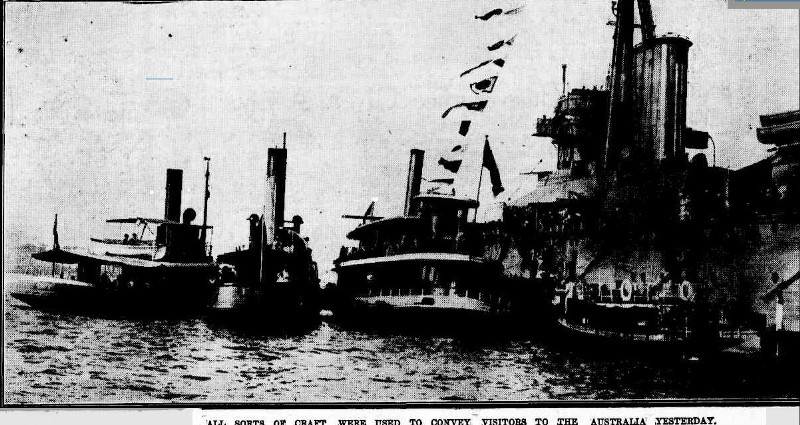
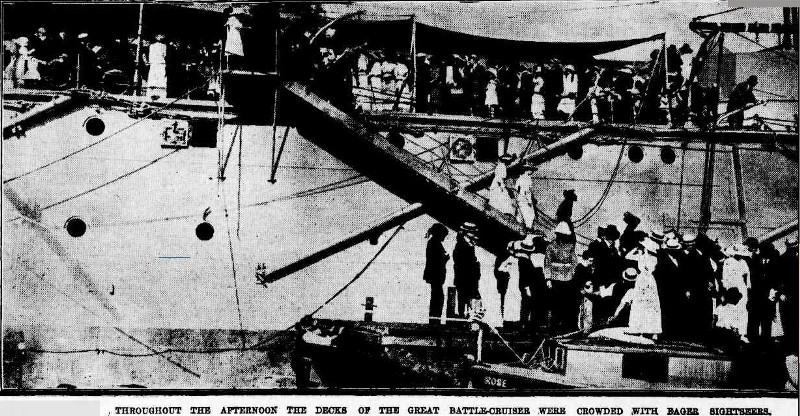
 Tuesday 7th of October 1913:
Tuesday 7th of October 1913: 1910. STARBOARD BOW VIEW OF THE SECOND CLASS PROTECTED CRUISER HMS CAMBRIAN, THE LAST FLAGSHIP OF THE AUSTRALIA STATION. NOTE THE 6 INCH GUN ON HER FORECASTLE AND THE 4.7 INCH GUNS TRAINED ON THE STARBOARD BEAM AWM image 302155
1910. STARBOARD BOW VIEW OF THE SECOND CLASS PROTECTED CRUISER HMS CAMBRIAN, THE LAST FLAGSHIP OF THE AUSTRALIA STATION. NOTE THE 6 INCH GUN ON HER FORECASTLE AND THE 4.7 INCH GUNS TRAINED ON THE STARBOARD BEAM AWM image 302155